Great American Rail-Trail FAQ
Indiana’s Cardinal Greenway | Photo by Tony Valainis
The Great American Rail-Trail is the nation’s first cross-country multiuse trail, stretching more than 3,700 miles between Washington, D.C., and Washington State. This trail is an iconic piece of American infrastructure that will connect thousands of miles of rail-trails and other multiuse trails, serving tens of millions of people living along the route as well as those who visit the trail from around the country and the world. Here are some of the Great American Rail-Trail’s most frequently asked questions.
Great American Rail-Trail FAQ
- What is Rails-to-Trails Conservancy’s role in building the Great American Rail-Trail?
- How can I help?
- How did RTC choose the preferred route of the Great American Rail-Trail?
- How has RTC engaged with the existing trails along the route?
- What will be the surface of the Great American Rail-Trail?
- What kinds of activities can I do on the Great American Rail-Trail?
- Can I travel on sections of the Great American Rail-Trail now?
- Will there be adequate lodging, food and water available along the Great American Rail-Trail?
- How does the Great American Rail-Trail differ from other long-distance trails in the United States?
- How much will it cost to complete the Great American Rail-Trail, and how will it be paid for?
- How long will it take to build the Great American Rail-Trail?
- How will the Great American Rail-Trail be maintained?
- Why is the Great American Rail-Trail Important?
- What is a rail-trail?
- Are there tips for planning for long-distance trips?
What is Rails to Trails Conservancy’s role in building the Great American Rail-Trail?
For decades, RTC has known the potential of building a rail-trail that spans the country, but the viability of this pursuit wasn’t confirmed until recently. Thanks to the incredible work of the entire trails community—from RTC itself, to trail managers, state agencies and countless volunteers—the potential route for this trail is more than 52 percent complete.
While the Great American Rail-Trail wouldn’t be possible without the work and partnership of the entire trails community, RTC is focused on leveraging its national expertise and organizational resources in support of trail completion. It will take a significant effort to ensure that the Great American Rail-Trail is well aligned as gaps are filled and the trail is completed between Washington, D.C., and Washington State. RTC national leadership is necessary to connect this trail—with a focus on negotiations between states and across jurisdictions, advocacy for trail funding at the state and federal levels, trail mapping analytics and planning, and marketing.
In addition, RTC has identified initial catalyst initiatives—projects or challenges that can spur trail completion and would most benefit from RTC’s breadth of resources. For example, along the preferred route of the Great American, RTC will provide trail planning assistance for completing trail gaps; generate public funding support for future trail development or open trail improvements; advocate for local and state trail priorities, and provide communications support and strategy to advance trail priorities along the route; and conduct research critical to advancing trail priorities. Through these initiatives, RTC will support local and state partners, investing time, expertise and organizational resources in specific projects that are important to the ultimate completion of the Great American Rail-Trail. Learn more about Great American Rail-Trail catalyst initiatives.
How can I help?
The Great American Rail-Trail won’t be completed overnight, and it won’t be completed without the help of trail lovers across the country. This is America’s trail, and it will take all of us through advocacy, volunteerism and donations to make it a reality. Sign up for news about the Great American Rail-Trail, and join RTC as we work with hundreds of partners across the country to connect these trails and complete this vision.
Support RTC today in its work to complete the Great American Rail-Trail and continue connecting trails across the country. If you are interested in corporate sponsorship or a personal gift of significance, email majorgifts@railstotrails.org.
The Great American Rail-Trail would not be possible without 145+ existing trails across the country that will host the preferred route between Washington, D.C., and Washington State. Ensuring these trails continue to thrive requires ongoing support from state and local officials, participation from local volunteers and funding support through individual donations. Connect with the trails hosting the Great American here.
How did RTC choose the preferred route of the Great American Rail-Trail?
A potential route for the Great American Rail-Trail began to materialize in the late 1980s and early 1990s, as RTC tracked rail-trail development nationally. Understanding the scale of this project, RTC set a threshold of identifying a route that was 50% complete before committing to complete the Great American Rail-Trail. That threshold was met in 2017, and RTC then began analyzing preferred routing across the country.
The resulting route assessment is the guiding document informing the preferred route of the Great American Rail-Trail. The assessment was developed in partnership with states and local trail organizations using RTC’s comprehensive GIS database of more than 34,000 miles of existing multiuse trails nationwide, and findings from the review of over 300 state and local trail plans to identify planned future trails. Key to the process of defining the preferred route of the Great American Rail-Trail with states and local trail partners was confirming a route across the country that would provide the highest-quality experience for all types of trail users—from long-distance cyclists and runners to casual daily explorers and everyone in between. In addition, RTC conducted dozens of meetings and phone calls with 200+ local trails partners and 50+ state agencies representing the trails along the route. These discussions informed the preferred route, ensuring it aligned with local and state priorities. Review the route assessment and criteria for the Great American Rail-Trail route here.
How has RTC engaged with the existing trails along the route?
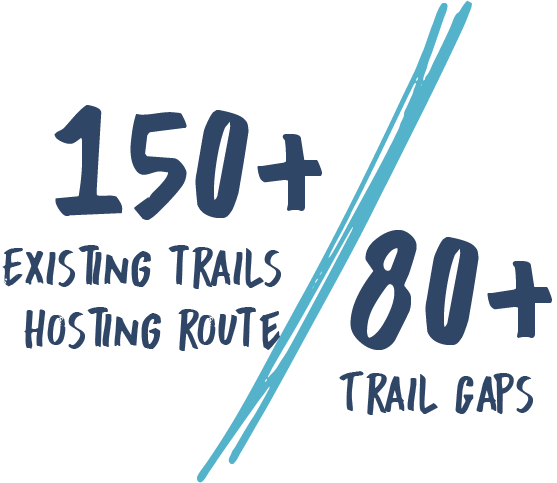
In order to identify the existing trails that could host the Great American Rail-Trail, as well as the potential ways to connect these trails to form a contiguous route across the country, RTC engaged in a series of dialogues with the managers of existing trails and stakeholders related to the potential gaps between them. The information gathered in these dialogues was invaluable to RTC’s work with the states to determine the preferred route of the Great American Rail-Trail.
The series of dialogues included initial webinars in July of 2018 to share information with trail managers about the endeavor; 137 trail managers were invited to participate. The same group of trail managers was invited to participate in a series of smaller group dialogues in September 2018. Resulting from the webinars and smaller group dialogues, RTC then reached out to these trail managers to conduct one-on-one interviews. The purpose of these interviews was to learn more information about each existing trail that could be part of the route, and information about local plans to extend these trails or build new trails that could be used for connection. RTC also conducted one-on-one calls and meetings with several stakeholders who were able to offer insight on efforts to build new trails.
In total, RTC conducted approximately 100 calls and meetings with existing trail managers and trail gap stakeholders between fall 2018 and spring 2019. The information gleaned in these conversations directly informs the preferred route of the Great American Rail-Trail as well as the text in the route assessment. RTC will continue to engage with these leaders and stakeholders as the Great American Rail-Trail matures over time.
What will be the surface of the Great American Rail-Trail?
The Great American Rail-Trail is hosted by more than 145 existing trails, each of which have their own surface type. You can learn more about the surfacing of each of the trails comprising the Great American Rail-Trail at TrailLink.com. You can also learn more about the different types of trail surfaces in our Trail-Building Toolbox.
What kinds of activities can I do on the Great American Rail-Trail?
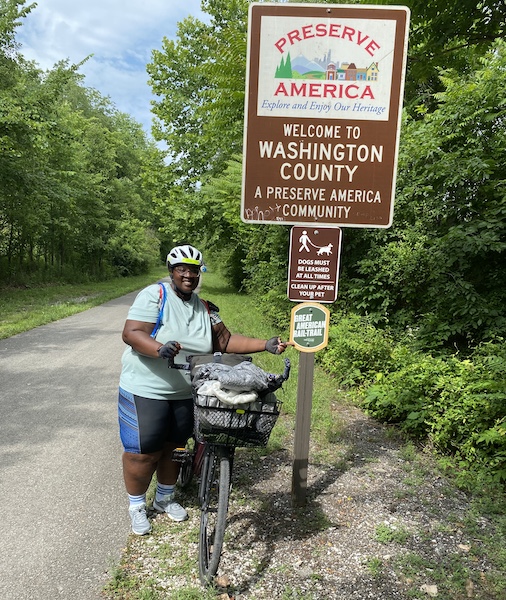
While rail-trails make up the majority of trails along the preferred route of the Great American, the entire route of the Great American Rail-Trail will be walkable and bikeable between Washington, D.C., and Washington State. Eventually, the entire route will be separated from vehicle traffic. Specific trail activities are decided upon by local trail managers. More information on the permitted uses for each trail can be accessed at TrailLink.com.
Can I travel on sections of the Great American Rail-Trail now?
Absolutely! The Great American Rail-Trail is hosted by more than 145 existing trails, and over 1,900 miles of the preferred route is open for use. In fact, several segments of these trails are connected—creating stretches of open trail longer than 50—and even 100—miles. On TrailLink.com, you can access maps and explore the existing trails that comprise the preferred route of the Great American Rail-Trail.
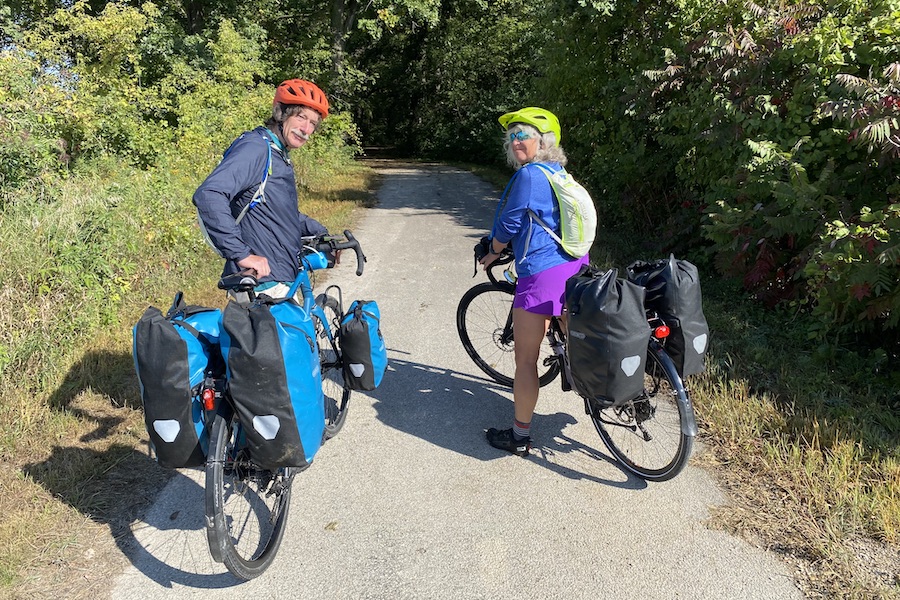
Will there be adequate lodging, food and water available along the Great American Rail-Trail?
RTC’s goal for this project is to use the future build-out of the trail as a catalyst for community economic development, especially in smaller communities along the route that are ripe for trail tourism.
Now, while the Great American Rail-Trail is not yet 100% complete, segments of trail along the preferred route are available for use. Many communities along the Great American Rail-Trail have options for lodging for trail users, from hotels and bed and breakfasts, to campgrounds and services such as Warm Showers that connect long-distance trail users with individuals who make their homes available for lodging and amenities. People planning overnight journeys on open sections of the Great American Rail-Trail should plan ahead to find lodging and bring adequate food and water.
Check out RTC’s TrailBlog for information on how to prepare for your first long-distance trail ride and how to be equipment ready. Plan your trip using TrailLink.com, where you can access maps and explore the existing trails that comprise the preferred route of the Great American Rail-Trail.
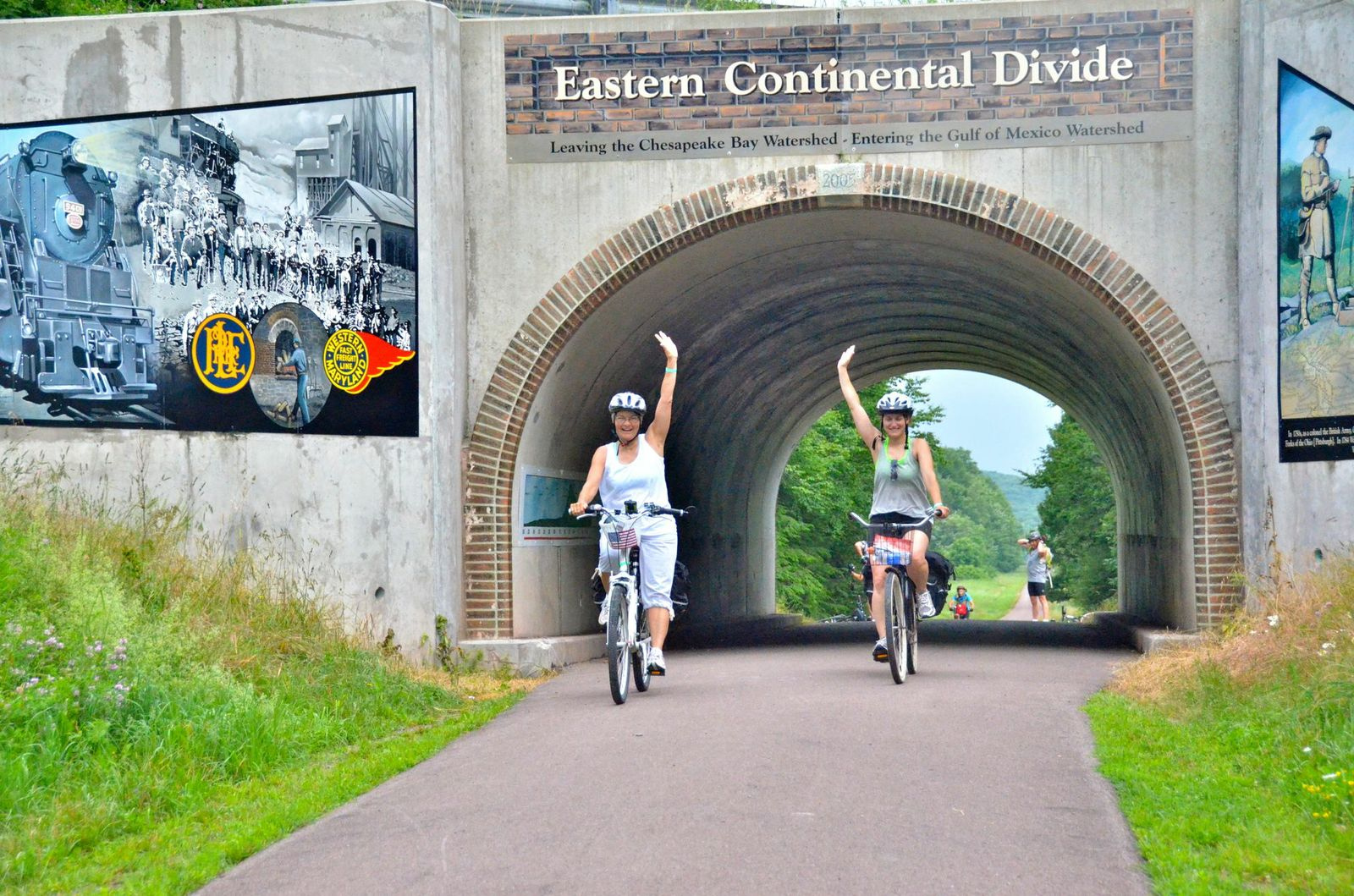
How does the Great American Rail-Trail differ from other long-distance trails in the United States?
The Great American Rail-Trail is a multiuse trail that spans the country between Washington, D.C., and Washington State. It is the first trail that will be entirely bikeable across the country and, when completed, separated from vehicle traffic. The preferred route will be hosted primarily on rail-trails, taking advantage of their gentle gradient—and the entire route will be available for walking and bicycling.
How much will it cost to complete the trail, and how will it be paid for?
While the Great American Rail-Trail is a bold vision that will take a significant investment of time and resources to complete, it will be worth it!
RTC estimates that the Great American Rail-Trail will cost approximately $1 billion to complete—a cost that will be entirely offset within five years as a result of visitor spending along the route.
RTC continues to work with state and local partners across the preferred route to determine costs associated with trail development. This data will provide the detail necessary to advocate for the federal, state and local funds and private investment that will be critical to completing the trail gaps along the route.
Based on RTC’s experiences completing regional trail networks across the country, we expect that a combination of federal funds dedicated to trail building, as well as state and local funds and private investment, will be critical to complete the trail gaps along the route.
Since the trail was announced in 2019, more than $54 million has been invested in projects that fill critical gaps along the route. The project could be accelerated with full funding of the Active Transportation Infrastructure Investment Program, which will make new direct federal grants available to connect trails and other active transportation infrastructure. This new program was created by the bipartisan federal infrastructure law and awaits funding through Congressional appropriations.
RTC actively advocates for federal and state programs used to support trail, walking and biking projects across the country, and will continue to do so.
How long will it take to build the Great American Rail-Trail?
The preferred route of the Great American Rail-Trail is more than 50 percent complete, and a significant portion of the trail gaps that need to be built are already in state and local plans. What’s more, the energy and enthusiasm behind the Great American Rail-Trail vision will give these state and local projects added momentum, which in turn will accelerate completion. This provides optimism that the timeline to complete the trail is within reach within the next few decades. Segments of trail will be completed with regularity as the work is done to connect the Great American Rail-Trail between Washington, D.C., and Washington State.
The Great American Rail-Trail will take several decades to bring to fruition—but the investment of time and resources necessary to complete this trail will be returned many times over as it takes its place among the country’s national treasures.
How will the Great American be maintained?
Trail maintenance is a critical need for all trails. RTC co-chairs the Coalition for Recreational Trails, which is working to increase federal investment in the Recreational Trails Program—a federal trail fund that specifically designates trail maintenance as an allowable use. If this campaign is successful, it will add considerable money for states to invest in maintenance. Federal funding through programs such as the Transportation Alternatives program has been essential to building trails in every state. RTC has consistently been and will continue to be central to establishing, protecting and increasing these federal investments in trails.
Read more about public funding for trails and active transportation on RTC’s website.
Read about the basics of trail management and maintenance at our Trail-Building Toolbox.
Why is the Great American Important?
As the Great American Rail-Trail® is completed, it has the potential to amplify the benefits—on a mass scale—that trails provide. In addition to offering places for physical activity and recreation, connecting diverse communities with safe walking and biking routes, and promoting a closer connection to nature, the Great American will serve as a catalyst for economic growth, helping communities along the route realize new economic potential. A recent analysis by Headwaters Economics found that the trail has the potential to generate more than $229.4 million in visitor spending, $104 million in labor income, and $22.8 million in new tax revenue. It presents new opportunities for business development and tourism for the hundreds of communities along its route, contributing to the growth of the country’s burgeoning outdoor economy—one of the fastest-growing sectors in the United States.
You can read the full study on the Impact page.
What is a rail-trail?
Rail-trails are multipurpose—or multiuse—public trails created from former railroad corridors. These paths are flat or gently sloping, making them easily accessible and a great way to enjoy the outdoors. Rail-trails are ideal for many types of activities, including walking, bicycling, wheelchair use, inline skating, cross-country skiing and horseback riding. Specific use is defined by the local trail manager.
Learn more about rail-trails at our Trail-Building Toolbox.
Are there tips for planning for long-distance trips?
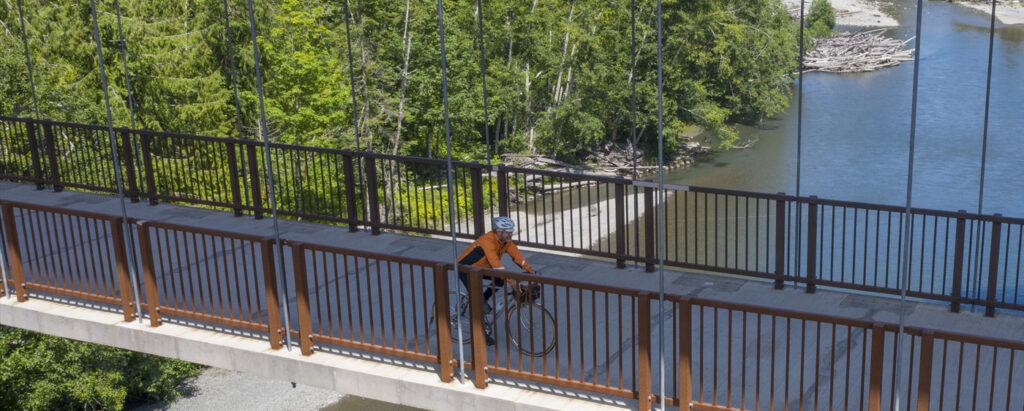
View our long-distance FAQ section to help you get started.